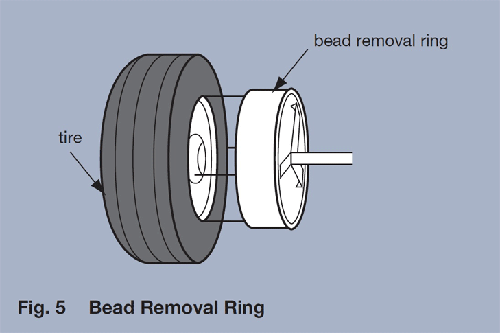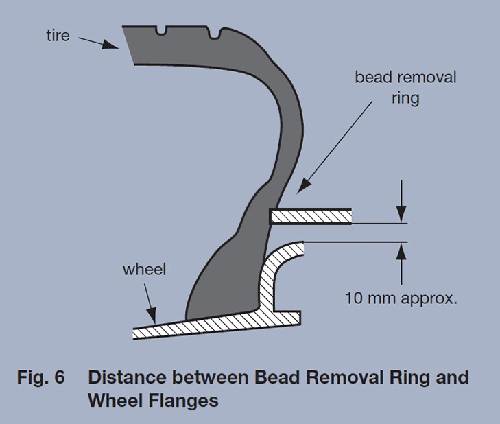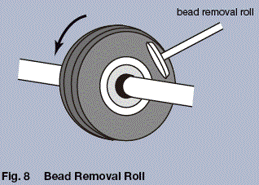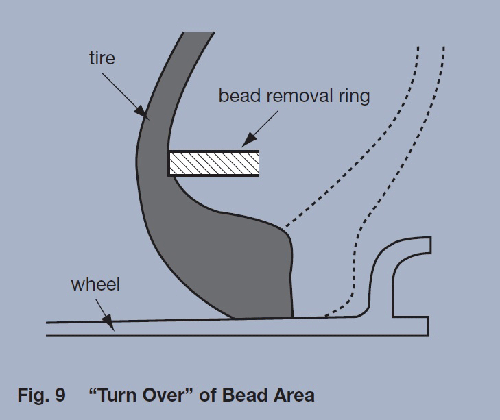Aircraft Tires
Care and Maintenance Instructions specific to radial tires
The care and maintenance of bias and radial tires is for the most part very similar. However, it is necessary to emphasize certain important differences.
1. Radial Tire Mixability
When operated under similar conditions, radial aircraft tires may exhibit different characteristics than those of bias aircraft tires. Bridgestone recommends that the following guidelines be heeded.
| a. | Aircraft need to be certified for use of radial tires in place of bias or vice versa. Questions arising concerning the certification of a given aircraft must be taken up with the airframe manufacturer. |
|---|---|
| b. | Radial tires should not be mounted on wheels designed for bias ply tires or bias tires on wheels designed for radial tires without first checking with the wheel or airframe manufacturer. |
Mixability of Bridgestone radial tires with bias tires is permitted only as expressly stated in the official airframe manufacturer's bulletin or specification. Any other use in unauthorized by Bridgestone Corporation.
2. Radial Tire Dismounting Procedure
A. Deflation
Before dismounting the tire from the wheel, completely release all remaining inflation pressure. Remove the valve core only after all pressure has been relieved.
WARNING
Removal of the wheel valve core on an inflated tire could project the core with dangerous speed and force.
B. Recommended Bead-breaker Press Design
The lower sidewalls of radial aircraft tires are significantly more flexible than those of bias tires, and are easily damaged by inappropriate dismounting procedures and/or equipment. For dismounting radial aircraft tires from their wheels, Bridgestone recommends the use of either a full-circle ring or a Dynamic roller to ease the tire beads away from the wheel flanges.
B-1 Full-circle Bead Ring Type



With this type of bead-breaker, a bead removal ring sized to fit specific tire size is used to apply pressure as close to the bead as possible on the area directly above the bead (Fig. 5). The space or distance between the removal ring and the wheel flange should be approximately 10mm (Fig. 6). Furthermore, the range of motion of the removal ring towards the tire center should be greater than 150mm, and the removal ring should be constructed to allow observation of the tire bead during dismounting. This may be achieved by designing "windows" in the removal ring (Fig. 7).
B-2 Dynamic roller Bead-breaker (Fig. 8)

Bridgestone has found that this type of bead breaker is the most efficient for large radial aircraft tires. The driven conical press wheels are forced against the lower sidewalls which rotate the wheel assembly and at the same time break the beads by gently moving the tire sidewalls inwards. This technique ensures there is no damage either in the tire bead area or the wheel flange.
C. Procedure for Dismounting Using Full-circle Bead Rings

Roll the tire into bead-breaker press and position the removal ring so that it evenly contacts the entire circumference of the bead. More than one technique may be applied to ease the tire bead away from the wheel flange. The preferred method is to reduce the bead-breaker press speed to 5mm/second and press the tire bead continually until the bead is dismounted. Using this method, the bead should separate smoothly from the wheel, often with the first application of force.
In the event that there may be concern about bead "Turn Over" (Fig. 9), an alternative method is recommended. Extend the bead ring laterally against the bead for a distance not exceeding 100mm, hold for two to three seconds, and retract the bead ring. Repeat this procedure until the bead is dismounted. The lateral speed of the bead ring should typically be about 30mm/second using this method.
The latter method should be used when the tire cannot be dismounted using the first method, or when the bead-breaker press cannot be set for low speeds.
D. Procedure for Dismounting Using a Dynamic roller
Mount the tire/wheel assembly in the bead-breaker press. Position the Dynamic roller against the bead as close as to the top of the wheel flange. While rotating the tire/wheel assembly, slowly apply force against the bead with the roller.
As with the full-circle bead ring method, care must be taken to avoid excessive sidewall deformation that could result in bead "Turn Over". The stroke of the Dynamic roller should not exceed 100mm.
E. Recommended Dismounting Procedure
Loosen the wheel tire bolts only after confirming that the tire beads have been completely released from the wheel. If the wheel tie bolts are loosened before the beads are completely released, the possibility exists that the wheel may be scratched or gouged.
After the tire bead is released from the wheel flange, insert a block of rubber or other material of appropriate size between the tire and the wheel flange to prevent the tire from returning to its original position. Inserting the block will facilitate the dismounting process.
The use of water or a soap solution as a lubricant will facilitate dismounting. Application of the water or soap solution while simultaneously applying pressure with the removal ring increases the effectiveness of the solution.
Category Link:
Tire Care and Maintenance
- 10. Removal by tire condition other than tread wear
11. Dismounting Bias Tires
12. Dismounting Radial Tires
13. Remounting of tires
14. Tire condition unsuitable for retreading - 15. Matching Tire Diameters
16. Tire Flat-spot
17. Protection from Contamination
18. Maintenance of Airport Surfaces - 19. Tires in Other than Aircraft Service
20. Storage of Tires
21. Handlings of tires
22. Transportation & Storage of Tire/Wheel Assemblies
23. Precautions during Unloading
24. Service Claim Memorandum

